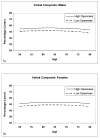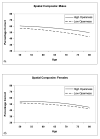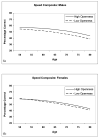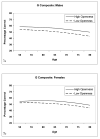Cognitive engagement and cognitive aging: is openness protective?
- PMID: 20230128
- PMCID: PMC2853722
- DOI: 10.1037/a0018748
Cognitive engagement and cognitive aging: is openness protective?
Abstract
The purpose of this study was to examine whether openness to experience is related to longitudinal change in cognitive performance across advancing age. Participants were 857 individuals from the Swedish Adoption/Twin Study of Aging (SATSA). Factors for 5 cognitive domains were created, including verbal ability, spatial ability, memory, processing speed, and a global score, g. Latent growth curve models were used to assess level and longitudinal trajectories of cognitive performance. It was hypothesized that individuals who endorsed higher levels of openness would have higher cognitive test scores and lesser rates of cognitive decline. As predicted, higher openness to experience was associated with significantly higher performance across all cognitive tests for both men and women even after adjusting for education, cardiovascular disease, and activities of daily living. Openness, however, was not predictive of differences in the trajectories of cognitive performance over age.
Figures








Similar articles
-
The role of occupational complexity in trajectories of cognitive aging before and after retirement.Psychol Aging. 2009 Sep;24(3):563-73. doi: 10.1037/a0015511. Psychol Aging. 2009. PMID: 19739912 Free PMC article.
-
The association of educational attainment, cognitive level of job, and leisure activities during the course of adulthood with cognitive performance in old age: the role of openness to experience.Int Psychogeriatr. 2016 May;28(5):733-40. doi: 10.1017/S1041610215001933. Epub 2015 Nov 26. Int Psychogeriatr. 2016. PMID: 26608394
-
Gender Differences in Longitudinal Trajectories of Change in Physical, Social, and Cognitive/Sedentary Leisure Activities.J Gerontol B Psychol Sci Soc Sci. 2018 Oct 10;73(8):1491-1500. doi: 10.1093/geronb/gbw116. J Gerontol B Psychol Sci Soc Sci. 2018. PMID: 27624718 Free PMC article.
-
Nonpharmacological cognitive interventions in aging and dementia.J Geriatr Psychiatry Neurol. 2007 Dec;20(4):239-49. doi: 10.1177/0891988707308808. J Geriatr Psychiatry Neurol. 2007. PMID: 18004010 Review.
-
Education and age-related decline in cognitive performance: Systematic review and meta-analysis of longitudinal cohort studies.Ageing Res Rev. 2020 Mar;58:101005. doi: 10.1016/j.arr.2019.101005. Epub 2019 Dec 24. Ageing Res Rev. 2020. PMID: 31881366
Cited by
-
Factors predicting reversion from mild cognitive impairment to normal cognitive functioning: a population-based study.PLoS One. 2013;8(3):e59649. doi: 10.1371/journal.pone.0059649. Epub 2013 Mar 27. PLoS One. 2013. PMID: 23544083 Free PMC article.
-
Training versus engagement as paths to cognitive enrichment with aging.Psychol Aging. 2014 Dec;29(4):891-906. doi: 10.1037/a0038244. Epub 2014 Nov 17. Psychol Aging. 2014. PMID: 25402337 Free PMC article. Clinical Trial.
-
Are trajectories of personality and socioeconomic factors prospectively associated with midlife cognitive function? Findings from a 12-year longitudinal study of Mexican-origin adults.Psychol Aging. 2023 Dec;38(8):749-762. doi: 10.1037/pag0000755. Epub 2023 Jun 15. Psychol Aging. 2023. PMID: 37326565 Free PMC article.
-
Personality Moderates Intervention Effects on Cognitive Function: A 6-Week Conversation-Based Intervention.Gerontologist. 2020 Jul 15;60(5):958-967. doi: 10.1093/geront/gnz063. Gerontologist. 2020. PMID: 31112605 Free PMC article. Clinical Trial.
-
The Russian scientists' quality of life and cognitive status.Eur J Transl Myol. 2021 Jun 16;31(2):9744. doi: 10.4081/ejtm.2021.9744. Eur J Transl Myol. 2021. PMID: 34148336 Free PMC article.
References
-
- Albert MS, Jones K, Savage CR, Berkman L. Predictors of cognitive change in older persons: MacArthur studies of successful aging. Psychology and Aging. 1995;10:578–589. - PubMed
-
- Andel R, Crowe M, Pedersen NL, Mortimer J, Crimmins E, Johansson B, Gatz M. Complexity of work and risk of Alzheimer's disease: A population-based study of Swedish twins. Journals of Gerontology: Psychological Sciences. 2005;60:251–258. - PubMed
-
- Andel R, Kareholt I, Parker M, Thorslund M, Gatz M. Complexity of primary lifetime occupation and cognition in advanced old age. Journal of Aging and Mental Health. 2007;19:397–415. - PubMed
-
- Baker TJ, Bichsel J. Personality predictors of intelligence: Differences between young and cognitively healthy older adults. Personality and Individual Differences. 2006;41:861–871.
-
- Balsis S, Carpenter BD, Storandt M. Personality change precedes clinical diagnosis of dementia of the Alzheimer type. Journals of Gerontology: Psychological Sciences and Social Sciences. 2005;60:98–101. - PubMed
Publication types
MeSH terms
Grants and funding
LinkOut - more resources
Full Text Sources
Medical
Research Materials

